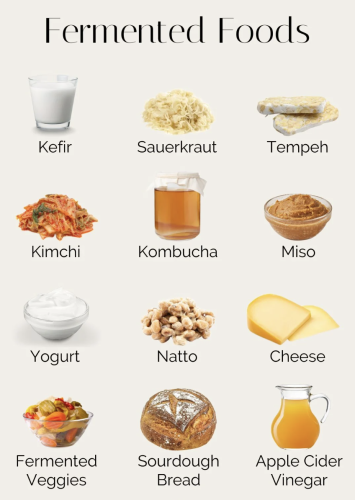Traditional Fermented Foods & Beverages | Global Health Benefits
Traditional Fermented Foods and Beverages from Around the World — Health Benefits
Fermentation is one of humanity’s oldest food preservation techniques, dating back thousands of years. More than simply extending shelf life, it enriches flavor, boosts nutrition, and supports gut health. Today, traditional fermented foods and beverages are staples in many diets globally, and they are increasingly backed by scientific research for their health-promoting properties.
Historically, fermentation was a necessity—a natural method to preserve perishable foods before refrigeration. Over time, it evolved into a cultural art, shaping regional cuisines across continents. The process depends on beneficial microorganisms—bacteria, yeasts, and sometimes molds—that generate probiotics, bioactive compounds, and distinctive flavors (Vinderola et al., 2023).
Asia: Origins of Many Iconic Ferments
Asia hosts some of the world’s most celebrated fermented foods. These are not merely culinary staples—they also offer nutritional and probiotic benefits.
Kimchi (Korea): A spicy, tangy mixture of fermented cabbage and vegetables. Studies show that regular consumption can alter fecal microbiota composition positively (Cha et al., 2024).
Miso & Natto (Japan): Soybean-based ferments prized for their umami flavor. Natto, in particular, has been studied for cardiovascular benefits, partly due to the enzyme nattokinase.
Idli & Dosa (India): Fermented rice-lentil batters produce fluffy cakes or crepes. These ferments enhance digestion of starches and improve absorption of nutrients.
Europe: Fermentation for Taste and Survival
European fermentation traditions often emerged from the need to preserve food during cold months, but they also gave rise to renowned flavors.
Sauerkraut (Germany): Fermented cabbage, high in lactic acid bacteria and vitamin C; associated with immune and digestive benefits.
Kefir (Caucasus & Eastern Europe): A fermented milk drink with a wide diversity of probiotic strains, linked to gut health and bone benefits (Leeuwendaal et al., 2022).
Sourdough Bread: Leavened by wild yeasts and lactic acid bacteria, sourdough often has a lower glycemic index and may be more digestible for some individuals.
Africa: Ferments in Daily Life & Nutrition
Fermentation is deeply embedded in African food systems as both tradition and nutrition strategy.
Injera (Ethiopia): A spongy flatbread made from fermented teff; dense in fiber and minerals.
Mahewu (Southern Africa): Fermented maize drink consumed for refreshment and energy.
Ogiri (Nigeria): A condiment from fermented oilseeds; used to enrich flavors in stews and soups, while also contributing microbial benefits.
The Americas: Indigenous Fermented Traditions
Fermented foods and drinks in the Americas often date back centuries, long before modern food processing.
Chicha (Peru & Ecuador): A traditional maize-based fermented beverage, sometimes used in ceremonial contexts.
Cacao Fermentation (Mesoamerica): A vital step in chocolate production; fermentation helps develop flavor and antioxidant compounds.
Curtido (El Salvador): A spicy cabbage relish, similar to sauerkraut but flavored with oregano and chili; offers probiotics and dietary fiber.
Australia: Aboriginal Heritage Ferments
Australian Aboriginal communities developed native fermentations tied to local flora:
Way-a-linah: Fermented drink from Tasmanian cider gum (Eucalyptus gunii).
Mangaitch: Created from flowering cones of Banksia species.
Tuba: Fermented coconut milk using palm toddy or coconut palm, often in clay-stoppered vessels.
Kambuda: Made from spiral-crushed nuts of the Pandanus tree in the Northern Territory.
What Science Confirms
Growing research confirms many traditional claims. Key benefits include:
Gut Health & Microbiome Modulation: Fermented foods can influence gut microbial diversity and composition (Leeuwendaal et al., 2022; Taylor et al., 2020).
Improved Nutrient Absorption: Fermentation can degrade anti-nutrients like phytates and enhance mineral and vitamin bioavailability (Nithya et al., 2023).
Immune Support & Bioactive Effects: Fermented products produce peptides, short-chain fatty acids, and other compounds that may regulate immune responses (Marco et al., 2021).
Potential in Chronic Disease Risk Reduction: Some epidemiological data link fermented food intake to lower risk of hypertension, type 2 diabetes, obesity, and metabolic syndrome (Soemarie et al., 2021).
However, while evidence is promising, more controlled human trials are needed to establish causality.
Safety & Caveats
Contamination Risks: Poor hygiene or uncontrolled environments can lead to unwanted pathogens or toxic byproducts.
Loss of Viable Microbes: Pasteurization or cooking may inactivate beneficial microbes, reducing probiotic potency.
Allergies / Sensitivities: Those with lactose intolerance, soy allergies, or histamine sensitivity should proceed cautiously.
Commercial Labeling: For commercial products, look for “live and active cultures,” strain identifiers, and whether pasteurization was applied.
References (APA)
Cha, J., et al. (2024). Does kimchi deserve the status of a probiotic food? [Journal reference].
Leeuwendaal, N. K., et al. (2022). Fermented foods, health and the gut microbiome. PMC.
Marco, M. L., et al. (2021). The International Scientific Association for Probiotics and Prebiotics consensus. npj Journal.
Nithya, A., et al. (2023). Probiotic potential of fermented foods and their role in non-communicable diseases. ScienceDirect.
Soemarie, Y. B., et al. (2021). Fermented foods as probiotics: A review. PMC.
Taylor, B. C., et al. (2020). Consumption of fermented foods is associated with subtle differences in gut microbiota. mSystems.
Vinderola, G., et al. (2023). Fermented foods: A perspective on their role in delivering health benefits. Frontiers in Microbiology.


